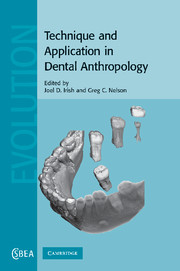Book contents
- Frontmatter
- Contents
- Contributors
- Acknowledgments
- Section I Context
- Section II Applications in assessing population health
- Section III Applied life and population history
- 9 Charting the chronology of developing dentitions
- 10 Dental age revisited
- 11 Primate dental topographic analysis and functional morphology
- 12 Forensic dental anthropology: issues and guidelines
- 13 Inter- and intra-specific variation in Pan tooth crown morphology: implications for Neandertal taxonomy
- 14 The quantitative genetic analysis of primate dental variation: history of the approach and prospects for the future
- Section IV Forefront of technique
- Index
- References
9 - Charting the chronology of developing dentitions
Published online by Cambridge University Press: 12 September 2009
- Frontmatter
- Contents
- Contributors
- Acknowledgments
- Section I Context
- Section II Applications in assessing population health
- Section III Applied life and population history
- 9 Charting the chronology of developing dentitions
- 10 Dental age revisited
- 11 Primate dental topographic analysis and functional morphology
- 12 Forensic dental anthropology: issues and guidelines
- 13 Inter- and intra-specific variation in Pan tooth crown morphology: implications for Neandertal taxonomy
- 14 The quantitative genetic analysis of primate dental variation: history of the approach and prospects for the future
- Section IV Forefront of technique
- Index
- References
Summary
Introduction
A primary goal of paleoanthropology, and indeed all sub-fields of paleontology, is to breathe life, metaphorically speaking, into fossilized remains of extinct species. Parsing out details of the phylogeny of a particular group of extinct organisms, inferring diet from comparative functional analyses of dentognathic remains, reconstructing locomotor repertoires, and sorting out brain/body size scaling relationships, etc., are but a few of the more prominent examples of how researchers make “fossils speak to us” from across vast stretches of time. Ever since the pioneering work of Schultz (1935, 1960), however, primatologists and paleoanthropologists have endeavored to reconstruct aspects of extinct species' schedule of growth, development, maturation, etc. – referred to as life history. Life history, simply put, is the schedule of key events in an organism's life cycle (e.g. gestation length, maternal–infant mass ratio, pre- and postnatal growth rates, age/weight at weaning, age at first reproduction, reproductive span, number of offspring per litter, inter-birth interval, etc.) that enable some individuals of a species to avoid predators or other mortality risks more effectively, or that in some way contribute to overall fitness (Godfrey et al., 2002; Ross, 1998). Thus, life history is the “direct outcome of the interaction between developmental variables (e.g. growth rate, age at skeletal maturation) and demographic variables (survival, reproduction, population growth, life-cycle stage census counts, etc.)” (Godfrey et al., 2002, p. 117).
When viewed in this light, it might seem impossible to infer such reproductive, physiological, and even behavioral parameters from fossilized remains.
- Type
- Chapter
- Information
- Technique and Application in Dental Anthropology , pp. 219 - 233Publisher: Cambridge University PressPrint publication year: 2008
References
- 1
- Cited by

